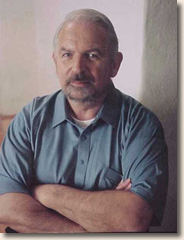Lyn Buchanan


Leonard (Lyn) Buchanan is the Executive
Director of Problems>Solutions>Innovations(P>S>I) which
started as a small data analysis company in the Washington, D.C. area in
1992 after Lyn's retirement from the military.
In late 1995, when the US government declassified their Remote Viewing
project, information became public about Lyn's prior involvement with
that project as one of the unit's Remote Viewers, Database Manager,
Property Book Officer and as the unit's Trainer. Public demands for
training and applications became great, and P>S>I moved into the
remote viewing field full time, bringing with it Lyn's extensive
databasing capabilities. At the present time, P>S>I possesses the
most complete body of data on the applications of remote viewing in
real-world applications.
The U.S. government used a specialized form of remote viewing known as
Controlled Remote Viewing (CRV). Lyn's involvement with CRV came about by
a long, strange, and circuitous series of events, some parts of which are
still classified. Lyn was brought into the unit in 1984 and remained there
on special assignment for the rest of his military career.
As a young man, Lyn had been a military computer expert for the
Nike Ajax/Nike Hercules guided missile systems. He had a 12-year
break in service, during which he gained a BA in Psychology, a BA in
Linguistics, and an MA in Linguistic Psychology. He then taught foreign
languages in East Texas. Re-entering the service in 1974, he became a
military linguist, specializing in German, Russian, and Spanish.
After re-entering the military, he was stationed in Japan for four years,
where he also gained a proficiency in Japanese and Mongolian, becoming the
only Mongolian linguist in all branches of the US military. After his
assignment to Japan, he returned to the Defense Language Institute for
another year to attend their higher-level Russian course and became one of
only 12 Russian Scientific Research Linguists in the US Army. He was then
assigned to a 4 year stint at the US Intelligence Field Station in
Augsburg, Germany, a station which deals with mostly tactical traffic and
very little scientific research traffic. But his skills and experience
with computers proved to be very rare, right at a time when the military
was just getting itself computerized. Here, he was also utilized as a
systems designer and programmer for the many and varied US- and
foreign-manufactured mainframe and mini-computers which were used at the
Field Station.
Lyn has been plagued throughout his life with "psychokenetic" events. One
fateful day in Augsburg, such an event, parts of which are still
classified, happened and brought about official recognition and record of
his "ability". Shortly thereafter, the commander of the U.S. Intelligence
and Security Command decided, because of these abilities, to transfer him
to the special "psychic spying" unit at Ft. Meade, Maryland, where he
planned to have Lyn affect and/or destroy enemy computer systems. This
plan was aborted for funding reasons, and Lyn became one of the unit's
Controlled Remote Viewers instead.
After retirement from the U.S. Army in 1992, he settled down with his wife
and youngest son in Mechanicsville, Maryland. He began working for a
"beltway bandit" (a term used for computer consultant companies which
surround the Washington D.C. beltway, and make their fortunes working
mainly governmental contracts). At the same time, he began building his
own company, Problems>Solutions>Innovations (P>S>I).
P>S>I was originally a data analysis company only.
During these years, he continued training people within the intelligence
community who were privy to the existence of CRV and to the fact that he
had been the unit's trainer. In December 1995, however, the CIA
effectively declassified the government's connection to and use of
CRV, and the existence of the military unit. The public became aware of
CRV, and P>S>I quickly took on the role of training CRV to the
public, keeping research data on the trained "CRVers", and developing new,
civilian applications for the technology.
Lyn has a personal drive to take this technology completely out of the
"spooky" realm and find the scientific and technological causes behind it.
To this end, he maintains a strict database on all operations in order to
conduct as much research as possible.
Adding his computer skills to the CRV process, Lyn has developed
techniques for enhancing the results of organized CRV efforts. He has
developed computerized analysis techniques for identifying, categorizing
and predicting viewer error rates. He has developed and maintains a
database which tracks a trained viewer's individual strengths and
weaknesses. He has also designed and written computer programs for the
specific areas of CRV training,to aid and guide the student's progress.
In addition to providing standard computer systems-oriented data analysis
and programming services, he also provides remote viewing services and
training to both individuals and organizations. He also performs a free
public service to police and other public-funded investigative
organizations and agencies.
This work was originally done under "The Assigned Witness
Program". The name for the program came about by chance one day when Lyn
was working with an investigator. He asked the investigator what
information was needed most. The investigator replied, "Well, what we
really need is a witness." "No problem", Lyn replied, "we can assign one."
For the first time, the investigator realized the scope of this new tool,
and asked, "Do you mean that you can assign someone to actually witness
something that has already happened?" Lyn replied, "That's what we
do."
Like so many of the other remote viewers of the military unit, Lyn is also
into art. To see some examples of his art work,
click here
